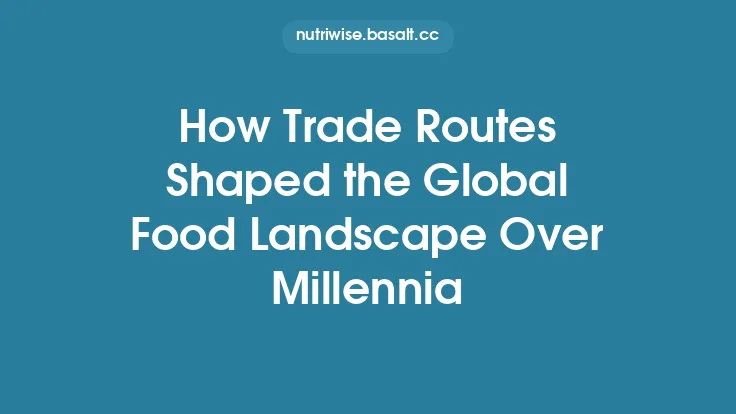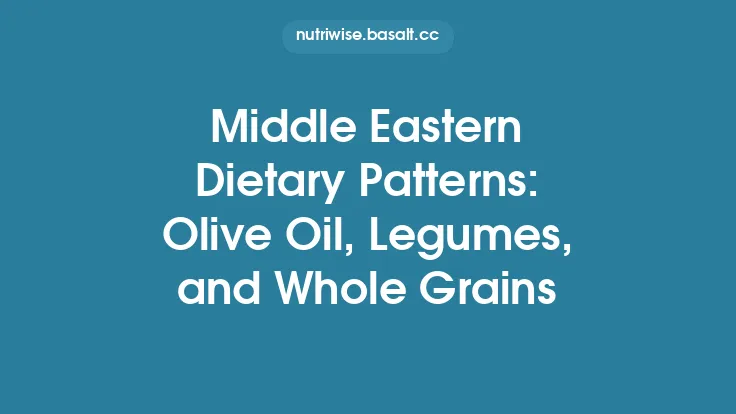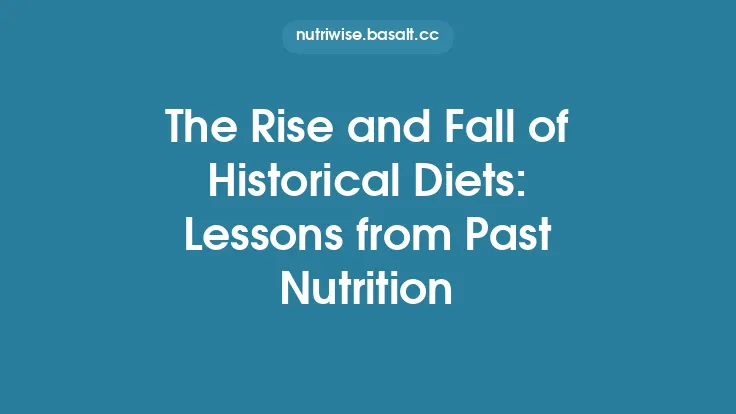The movement of peoples, goods, and ideas along ancient trade arteries reshaped what societies ate long before the modern supermarket existed. From the high passes of Central Asia to the bustling ports of the Indian Ocean, merchants carried not only silk, gold, and ceramics but also seeds, tubers, livestock, and culinary practices. These exchanges forged a mosaic of dietary possibilities that still defines regional cuisines today. By tracing the major routes, the commodities they moved, and the social mechanisms that facilitated adoption, we can understand how historical trade laid the groundwork for today’s remarkable dietary diversity.
The Silk Road: A Corridor of Crops and Livestock
The overland Silk Road, a network of caravan routes linking China, Central Asia, the Middle East, and the Mediterranean, is best known for its silk and jade. Yet its agronomic impact was equally profound. Archaeobotanical evidence from sites such as Turpan (Xinjiang) and Samarkand (Uzbekistan) shows the introduction of wheat (Triticum aestivum) and barley (Hordeum vulgare) from the Fertile Crescent into East Asian agricultural zones during the first millennium CE. Conversely, Chinese millet (Panicum miliaceum) and rice (Oryza sativa) traveled westward, establishing footholds in the highlands of Central Asia where they complemented existing grain systems.
Livestock followed similar pathways. The Bactrian camel (Camelus bactrianus), already native to the steppes, became a primary pack animal for transporting goods across the desert, while the introduction of sheep (Ovis aries) and goats (Capra hircus) from the Near East facilitated the spread of dairy and meat products into regions previously reliant on cattle. These animal introductions also brought new husbandry techniques, such as transhumant grazing, which reshaped pastoral economies along the route.
The Silk Road’s impact on dietary diversity was not a one‑way flow. Local culinary customs—such as the Central Asian practice of fermenting dairy into kumis—were adopted by travelers and later recorded in Chinese medical texts, illustrating a bidirectional exchange of food culture.
Maritime Spice Routes: Beyond Spices – Staples and Fruits
While the term “spice route” evokes peppercorns and cloves, the maritime corridors that linked the Arabian Peninsula, the Indian subcontinent, Southeast Asia, and East Africa carried a broader cargo of edible plants. The monsoon‑driven voyages of Arab and later Portuguese ships facilitated the movement of staple crops such as sorghum (Sorghum bicolor) from Africa to the Indian Ocean islands, and the introduction of mango (Mangifera indica) from South Asia into the Swahili coast.
Coconut palms (Cocos nucifera) provide a striking example of a maritime diffusion. Genetic studies indicate multiple introductions of coconut varieties across the Indian Ocean, each associated with distinct trade nodes. The coconut’s versatility—providing water, flesh, oil, and fiber—made it a valuable commodity that quickly integrated into local diets, influencing cooking methods (e.g., coconut milk stews) and food preservation techniques (e.g., desiccated coconut for long voyages).
The maritime routes also enabled the spread of legumes such as pigeon pea (Cajanus cajan) and black gram (Vigna mungo), which became essential protein sources in coastal agrarian societies that lacked large herds of livestock.
Trans‑Saharan Caravans: Grain and Pulse Exchanges
The Sahara Desert, once a formidable barrier, became a conduit for trade through a series of well‑established caravan routes linking West Africa with the Mediterranean world. Salt, gold, and ivory dominated the high‑value trade, but grain and pulse exchanges were equally transformative.
Millet (Pennisetum glaucum) and sorghum, already staple cereals in the Sahel, were introduced northward into the Maghreb, where they complemented wheat‑based diets. In return, durum wheat (Triticum durum) and barley traveled south, allowing for the production of flatbreads and porridges that blended with local grain preparations.
Pulses such as cowpea (Vigna unguiculata) and lentils (Lens culinaris) also moved along these routes. Their nitrogen‑fixing properties made them valuable for soil fertility, encouraging their cultivation in marginal lands and diversifying the protein base of both northern and southern populations.
The Indian Ocean Trade Network: Rice, Coconut, and Tropical Produce
The Indian Ocean’s monsoon winds created a predictable schedule for sailing vessels, fostering a dense web of trade among East Africa, the Arabian Peninsula, the Indian subcontinent, and the islands of Southeast Asia. Rice (Oryza sativa) stands out as a cornerstone of this network. While rice cultivation originated in the Yangtze River basin, varieties such as the aromatic basmati and the short‑grain japonica spread westward via merchant ships, eventually establishing themselves in the coastal plains of the Arabian Gulf and the Swahili coast.
The movement of tropical fruits—pineapple (Ananas comosus), papaya (Carica papaya), and banana (Musa spp.)—followed similar patterns. These fruits, originally domesticated in Southeast Asia and the Pacific, were introduced to the Indian subcontinent and East Africa, where they became integral to local diets and agricultural systems. Their rapid growth cycles and adaptability to diverse climates facilitated their integration into smallholder farms, enhancing seasonal food availability.
The Columbian Exchange: A New Chapter in Global Diets
The arrival of European powers in the Americas in the late 15th century inaugurated a trans‑Atlantic flow of organisms that dwarfed earlier exchanges in scale. While the term “Columbian Exchange” often highlights the transfer of potatoes, tomatoes, and maize, its broader impact on dietary diversity lies in the sheer number of new species that entered Old World agriculture.
Maize (Zea mays) and cassava (Manihot esculenta) migrated to Africa, where they became staple crops in regions previously dependent on millet and sorghum. In Asia, the introduction of chili peppers (Capsicum spp.) transformed flavor profiles across cuisines, but more importantly, it added a new source of vitamin C and a means of food preservation through drying and fermentation.
Conversely, Old World crops such as wheat, rice, and sugarcane were introduced to the Americas, reshaping indigenous agricultural systems. The establishment of sugarcane plantations in the Caribbean and Brazil, while later linked to labor exploitation, also created a new commodity that would dominate global trade for centuries, influencing dietary patterns through the widespread availability of refined sugar.
Mechanisms of Culinary Diffusion: Marketplaces, Intermarriage, and Religious Institutions
Trade routes alone did not guarantee the adoption of new foods; social mechanisms mediated the diffusion. Marketplaces served as nodes where merchants displayed unfamiliar produce, allowing local consumers to sample and purchase. Over time, these items entered household gardens and communal fields.
Intermarriage between merchant families and local elites facilitated the exchange of culinary knowledge. Historical records from the Ottoman Empire, for example, document Persian brides introducing pomegranate (Punica granatum) orchards into Anatolian estates, thereby integrating the fruit into regional gastronomy.
Religious institutions—mosques, temples, and monasteries—also acted as custodians of agricultural knowledge. Monastic gardens in medieval Europe cultivated exotic legumes introduced via Mediterranean trade, while Buddhist monasteries in Southeast Asia maintained rice paddies that incorporated new varieties brought by Indian traders.
Long‑Term Impacts on Regional Food Systems
The cumulative effect of these exchanges is evident in the agrobiodiversity of contemporary food systems. Regions that once relied on a narrow set of crops now cultivate a mosaic of species, each adapted to specific microclimates and cultural preferences. This diversification has implications for food security, as multiple staple options reduce vulnerability to climate‑induced crop failures.
Moreover, the integration of foreign crops often led to the development of new agronomic practices. The introduction of irrigation techniques from Persia into the Indian subcontinent, for instance, enabled the expansion of rice cultivation into arid zones, reshaping settlement patterns and labor organization.
Archaeological and Historical Evidence of Dietary Shifts
Archaeobotanical analyses—such as pollen cores, phytolith studies, and carbonized seed identification—provide concrete evidence of dietary change. At the site of Çatalhöyük (modern Turkey), charred wheat grains dating to the 7th millennium BCE coexist with later layers containing barley and millet, indicating successive introductions via trade.
Historical texts complement these findings. The 10th‑century Chinese “Qimin Yaoshu” records the cultivation of wheat and barley in the western regions of the empire, attributing their presence to “foreign merchants.” Similarly, the 13th‑century Arab geographer Ibn al‑Awlād notes the presence of rice paddies along the East African coast, a direct result of Indian Ocean trade.
Contemporary Reflections: Legacy of Historical Trade in Modern Food Landscapes
Today’s global food map bears the imprint of centuries‑old trade routes. The prevalence of wheat in North Africa, rice in the Gulf states, and maize in West Africa can all be traced back to specific commercial corridors. Understanding this lineage helps explain why certain cuisines possess a rich tapestry of ingredients that, at first glance, appear geographically incongruent.
The historical perspective also underscores the resilience of food cultures. Communities have repeatedly adapted to new crops, integrating them into existing culinary frameworks while preserving core traditions. This adaptive capacity, forged through trade, continues to shape dietary diversity in an increasingly interconnected world.
By examining the pathways, commodities, and social processes that defined ancient trade, we gain a clearer picture of how the world’s diets became the complex, interwoven tapestry they are today. The legacy of these routes reminds us that food is not merely sustenance; it is a living record of human movement, exchange, and ingenuity.





